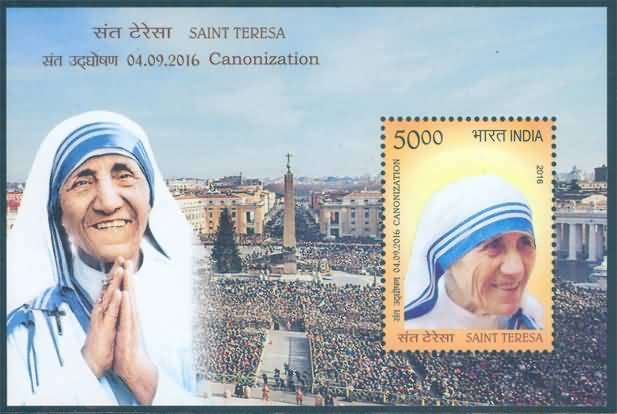Saint Teresa

Technical Data
| Date of Issue | September 4, 2016 |
|---|---|
| Denomination | Rs. 50 |
| Quantity | 400,000 |
| Perforation | 13¾ |
| Printer | Security Printing Press, Hyderabad |
| Printing Process | Wet Offset |
| Watermark | No Watermark |
| Colors | Multicolor |
| Credit (Designed By) | Smt. Alka Sharma |
| Catalog Codes |
Michel IN BL145 Yvert et Tellier IN BF132 Stanley Gibbons IN MS3175 |
| Themes | Famous people | Nobel Laureates | Religion | Saints | Women |
Early Life and Calling
Mother Teresa, born Agnes Gonxha Bojaxhiu in 1910 to an ethnic Albanian family in Skopje, grew into an icon of compassion and mercy. In 1929, she arrived in India as a Sister of Loreto, beginning her service as a teacher. On 24 May 1937, she made her Final Profession of Vows, becoming “Mother Teresa,” a title she held with profound devotion. Her early years at St. Mary’s School were marked by kindness, dedication, prayer, and a deep love for her students and religious sisters.
The ‘Call Within a Call’
Despite her fulfilling life in the convent, the stark poverty around her stirred her heart deeply. In 1946, she experienced what she described as a “call within a call”—a divine mandate to leave the comfort of the convent and serve the poorest of the poor. This moment transformed the course of her life and laid the foundation for one of the greatest humanitarian missions of the 20th century.
Founding of the Missionaries of Charity
In 1950, Mother Teresa founded the Missionaries of Charity, a congregation rooted in four vows: chastity, poverty, obedience, and a fourth unique vow—wholehearted free service to the poorest of the poor. The congregation grew rapidly, and by 2012, had over 4,500 sisters serving worldwide. Their homes provided food, shelter, education, and care to the destitute, sick, disabled, abandoned, and dying—offered freely and without discrimination.
Expansion Across the World
In 1965, Pope Paul VI granted a Decree of Praise, allowing the congregation to expand outside India. New homes opened in Venezuela, Rome, Tanzania, and gradually across Asia, Africa, Europe, and including Mother Teresa’s homeland, Albania. Through these institutions, the Missionaries of Charity became a beacon of hope, extending the message of love and compassion far beyond India.
Recognition, Awards, and Global Impact
Mother Teresa’s profound humanitarian work earned her numerous international awards, including the:
- Pope John XXIII Peace Prize (1971)
- Nehru Prize for International Peace and Understanding (1972)
- Balzan Prize
- Templeton Award
- Magsaysay Award
- Nobel Peace Prize (1979)
Yet she continually insisted that she was merely “a pencil in the hand of God,” working only to serve those most in need.
Path to Sainthood
After her passing in 1997, Pope John Paul II waived the usual five-year waiting period to begin the canonization process.
- In 2002, the Vatican recognized the first miracle attributed to her intercession.
- On 20 December 2015, Pope Francis acknowledged a second miracle—a cure of a Brazilian man suffering from a severe brain infection.
These miracles paved the way for her canonization as a Saint, marking her life as a model of Christian virtue and humanitarian love.
Legacy of Compassion
Mother Teresa’s canonization coincided with the Year of Mercy, reinforcing her lifelong mission of embodying God’s love through simple acts of care. Her tireless dedication to the poor, her gentle smile, and her unwavering faith continue to inspire millions across the world.
Today, she stands as an enduring symbol of service—reminding humanity that even the smallest gestures of kindness can light the fire of peace and compassion across the world.

Leave a Comment
You must be logged in to post a comment.